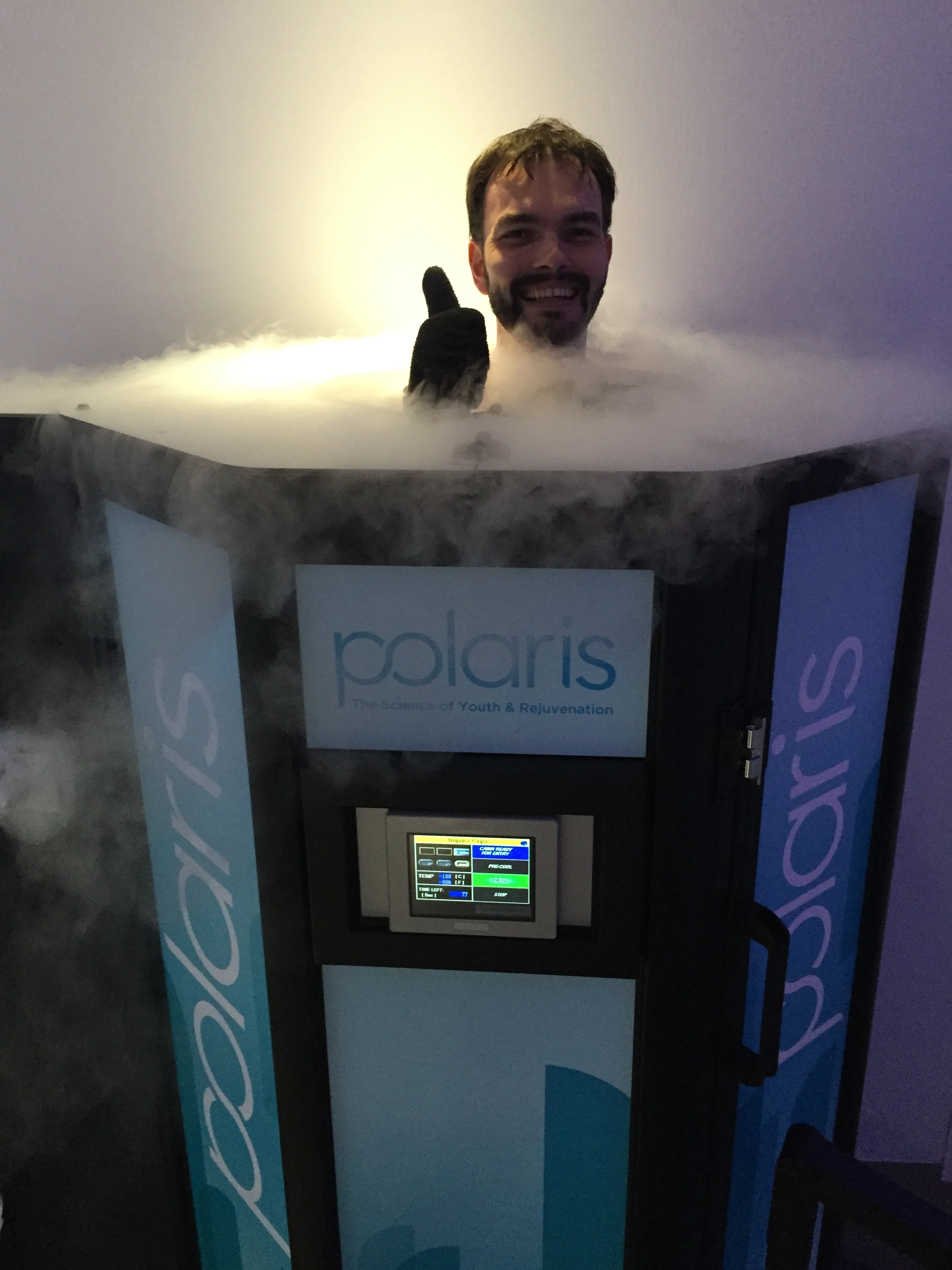Nipple Stickers and Deep Freezers – My First Experience in a Cryo Sauna
I wrote a pretty long Life-Sparring round about my experiments with cold shock therapy, titled Cold Is Pretty Hot Right Now – Freezing for Health, Beauty and Longevity, not too long ago.
While doing some background research for the article, I stumbled upon the first commercial cryo chamber in Hong Kong, which had just opened its doors in April of this year. Around the time I got serious with my cold shock experiments. Obviously I had to follow in Joe Rogan’s Bigfoot-sized footsteps and had to give it try.
Cryotherapy is the most intense form of cold shock therapy. While cold showers have limited cooling powers (especially in a summer in Hong Kong), ice packs can only be used locally and easily cause “ice burns,” and ice baths are not easy to manage and pretty damn uncomfortable, cryo chambers use liquid nitrogen to expose you to temperatures below -100 degrees within seconds.
Most of the published papers on the benefits of cold shock therapy are either based on whole-body cryotherapy, the use of cryo saunas (with the head sticking out) or fairly lengthy ice baths. So I was extremely interested to see if through cryotherapy I would be able to trigger the almost magical benefits credited to cold shocks: lowered inflammation (through release of norepinephrine), increased immune function, weight loss (through shivering and non-shivering thermogenesis), increased testosterone levels, improved mood and better sleep. If you want to dive deeper into this, I can only repeat my recommendation to check out Dr. Rhonda Patrick’s podcast, Found My Fitness. Dr. Patrick has several podcast episodes dedicated to cold shock therapy (among others with “Ice Man” Wim Hof or NASA scientist Ray Cronise). Dr. Patrick also wrote a white paper on cold shock therapy, which I cited in the last ice-cold Life-Sparring round.
Polaris Wellness, Hong Kong
Hong Kong’s first cryo sauna, Polaris Wellness, occupies some prime real estate in the heart of Causeway Bay (10th floor, Lee Theatre, 99 Percival Street). The sleek and futuristic spa only offers full-body and localized cryotherapy, and recently added light therapy for skin rejuvenation to its menu of services.
I contacted Polaris through their Facebook page and after they offered me an opening promotion of two sessions for the price of one, I instantly made an appointment via email.
Upon arriving at the facilities for my first visit, I was seated in a lounge area at the entrance, on a chair equally stylish as uncomfortable. I filled out a brief registration form and the receptionist asked if she could snap a picture for future check-ins. She also gave me a quick version of the sales pitch on the benefits of cryotherapy, pretty much bullet points without too many scientific references.
After a few minutes of waiting I was led to a room farther inside the spa for a “health assessment” that mainly consisted of four or five very general health questions such as, “How often do you work out? Do you take any drugs? Do you have a stressful job?” and having my blood pressure taken by a Wi-Fi iPhone blood pressure monitor. I assumed the process was primarily a precaution to litigation. I also received a bathrobe and the warm advice from the receptionist to use the nipple stickers, and was guided to a changing room.
The changing room is, by HK standards, fairly big and as stylish as the rest of the premises. The only thing missing, from my point of view, was a lockable wardrobe for valuables.
Nipple Stickers - There's always a first time!
I changed to the bathrobe and disposable briefs and socks, and following the well-meant advice, covered my nipples with the provided stickers. Fun!
After waiting a few more minutes due to a required change of a gas canister, I was called to the treatment room, dominated by the giant cryo tank and a small table in the corner. I put on gloves, took off the robe and climbed into the tank.
Different from the full-body cryo chamber that Joe Rogan frequents in Los Angeles, the Polaris cryo tank is open at the top, so that the head is not submerged. The machine has three different settings: -110, -130 and -150 degrees Celsius. The actual temperature reached varies slightly and goes down over the three minutes of the treatment.
Usually it’s recommended that first-timers go with one of the first two settings and not go full blast right away, so I took the golden middle of -130 degrees Celsius.
After a user enters the tank, nitrogen streams into the tank from a nozzle at the side. As the temperature varies within the tank, you are reminded by the therapist to turn 90 degrees every 45 seconds. The therapist in my case was actually the CEO and founder of Polaris, Nawfel Oussedik, who got the inspiration for the business idea from the U.S., where he experienced cryotherapy himself.
Happy Deep Freezing
Starting with my hands on the rim of the tank at the beginning, I ended with my arms within the tank. Surprisingly, the three minutes at -130 degrees passed incredibly fast. Knowing that time is relative, I would have assumed that 180 seconds at that temperature would feel like an eternity. And while I definitely felt the cold, it was not painful nor did I even shiver. This was particularly interesting, as calorie torching through the so-called “shivering thermogenesis” is one of the main selling arguments for the therapy. As I also rarely ever shivered during cold showers, anecdotal evidence is mounting up that there might be some truth to the potential reduced thermogenesis in relations with my FTO gene variation (read more about my gene analysis in Deconstructed me – What I learned about myself through DNA analysis).
In the direct aftermath to the first session I felt pretty good. Taking the subway home, I felt refreshed and “alert.” However, those were about the only noticeable effects. My night’s sleep was fairly average and I did not really feel different in the morning.
My second session went similar to the first. After skipping the registration process, I got the same “medical check” and then went to the changing room.
This time I went for the maximum freeze: -150 degrees. Again I did not really experience any shaking and had no problem withstanding the cold. However, I had a very brief moment of anxiety, but it passed quickly.
As it was the second of my two-for-one promotion, I sat down after the treatment to discuss the membership options. Sadly, that was when reality kicked in. At HK$900 (US$115) per single session, cryotherapy at Polaris is priced just like an hour with a top personal trainer. Through commitment to a package the single session prices can be brought down significantly; however, the multi-session deals are serious financial commitments. Even at my relatively comfortable manager salary, it’s a commitment beyond my comfort zone.
Don’t understand this as criticism of Nawfel and the Polaris team. From a strategic perspective their offers and prices definitely make sense. Sky-high rents are part of Hong Kong’s reality and the Polaris Spa is luxuriously designed and laid out. Being a pioneering endeavor at the edge of technological development, Polaris and its founders are taking a great risk and mitigate this by aiming at an elite clientele with deep pockets that is also more likely to try out and adopt a relatively new technology.
However, for myself this means a long-term test of the magic of cryotherapy has to be delayed until I either strike gold or the prices for cryotherapy in Hong Kong come down to U.S. prices, where you can get whole-body cryo sessions for US$45. This would likely require a few more spas to open, preferably more mass market-oriented, maybe set up in an industrial building outside of the major commercial zones. If cryotherapy is as magical as many say, we will eventually get there.









